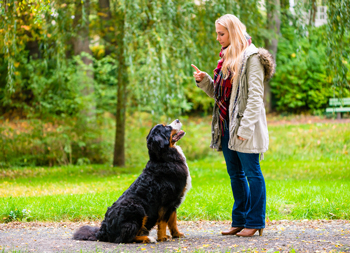How to Teach a Dog to Stay

Staying in a particular spot when you want her to is one of the basic things you'll need your dog to know. The stay command is an essential one for your dog to follow well both for good canine manners and for safety.
Like any command, you'll need to teach your dog to stay, and this can be a little trickier for some dogs to learn than sit, come, or down.
Why Is Stay a Difficult Command for Dogs?
Stay can be tricky for some dogs to learn because you will not necessarily be right next to your dog while she is staying. Dogs find it difficult not to jump up and bound over to their human, where they ultimately love to be.
There are three parts to the stay command: time, distance, and distraction. The longer you ask your dog to stay, the further away from her you are while she's staying, and the more distractions that are tempting her to get up, the more difficult it will be for her to stay.
You will need to practice your dog's stay with her often and during as many variations of these three components as you can.
However, when your dog is first learning to stay, start with short times and make it as easy as you can for your dog to be successful. This will set the groundwork for you to gradually add time, distance, and distractions to the mix.
Steps for Teaching a Dog to Stay
Before you teach your dog the stay command, she should know the sit or lie down command. You can learn more about that here: "How to Teach Your Dog to Sit " or "How to Teach a Dog to Lie Down."
When you are first teaching your dog to stay, do so in a small, familiar, safe area with no distractions.
- First, give your dog a sit or lie down command.
- Once your dog is in the proper position, hold off for a second before saying "yes" or "good" and giving a treat. Move low with the treat, toward the floor, so your dog isn't encouraged to jump up to get the treat.
- Over time, gradually wait a bit longer before giving your dog the treat after she sits or lies down for you.
- Once your dog is staying put for a few seconds after the sit or lie down command, add the word "stay." You may also wish to hold your hand up toward her face in a "stop" position.
- Gradually add more and more time to your dog's stay. You will also want to add a release word, such as "OK" after a few training sessions.
- Once your dog is reliably staying and releasing on cue, you can start to add different challenges. Start with moving away from your dog a tiny bit at a time. Eventually, you should be able to leave your dog's sight and still expect her to stay until you release her. You can also work on longer stays and then work on adding distractions, such as a toy or a treat placed nearby.
Training Tips for Dogs
Below are some general tips for successfully training your dog to respond to new commands.
- It's best to train your dog after a good play session. She'll be better able to focus and learn if she isn't full of energy. It's also good if she hasn't just had a big meal.
- Training your dog when she's a bit hungry will help her to be more interested in earning treats.
- Clicker training is a great way to teach dogs new commands. You can learn more about it here: "Clicker Training for Dogs: An Overview."
- Don't train for too long at once. It's best to limit your training sessions to 5-10 minutes once or twice a day.
You May Also Like These Articles:
Tips for the First Few Weeks with Multiple Dogs
How Do You Stop a Dog from Barking?
How to Teach Your Dog to Play Tug-of-War
Dog Training Tips: Using Treats Properly
Disclaimer: This website is not intended to replace professional consultation, diagnosis, or treatment by a licensed veterinarian. If you require any veterinary related advice, contact your veterinarian promptly. Information at DogHealth.com is exclusively of a general reference nature. Do not disregard veterinary advice or delay treatment as a result of accessing information at this site. Just Answer is an external service not affiliated with DogHealth.com.
Notice: Ask-a-Vet is an affiliated service for those who wish to speak with a veterinary professional about their pet's specific condition. Initially, a bot will ask questions to determine the general nature of your concern. Then, you will be transferred to a human. There is a charge for the service if you choose to connect to a veterinarian. Ask-a-Vet is not manned by the staff or owners of DogHealth.com, and the advice given should not delay or replace a visit to your veterinarian.



